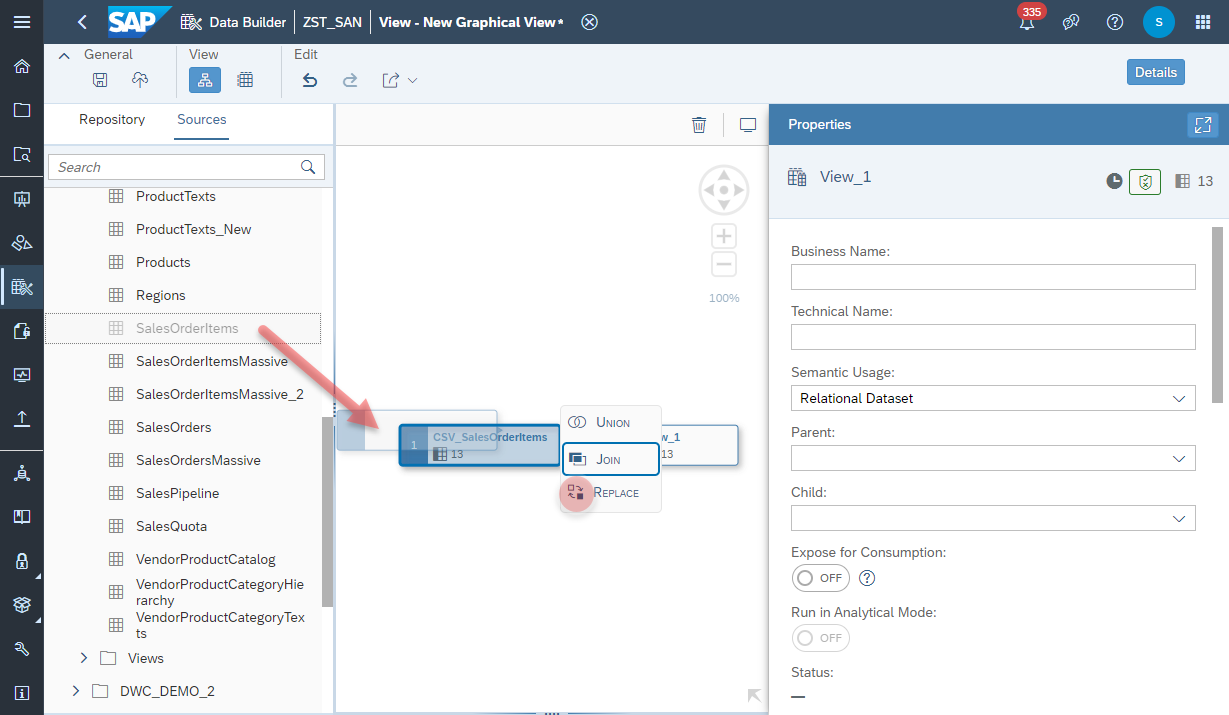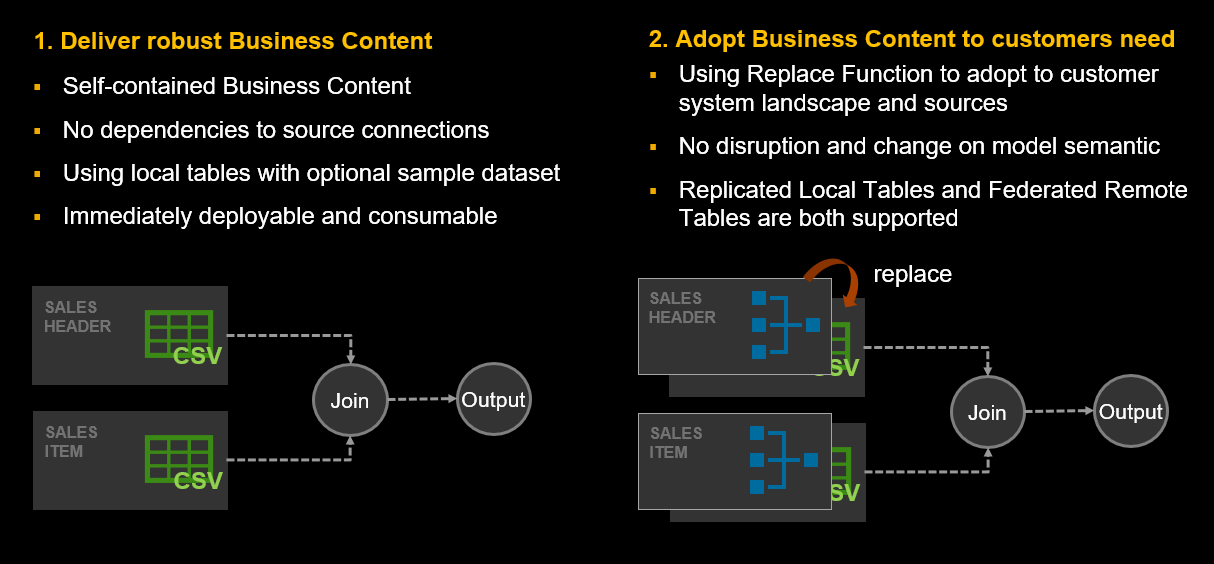
- SAP Community
- Products and Technology
- Technology
- Technology Blogs by SAP
- Using "Replace Table" function to deliver robust B...
Technology Blogs by SAP
Learn how to extend and personalize SAP applications. Follow the SAP technology blog for insights into SAP BTP, ABAP, SAP Analytics Cloud, SAP HANA, and more.
Turn on suggestions
Auto-suggest helps you quickly narrow down your search results by suggesting possible matches as you type.
Showing results for
Advisor
Options
- Subscribe to RSS Feed
- Mark as New
- Mark as Read
- Bookmark
- Subscribe
- Printer Friendly Page
- Report Inappropriate Content
09-17-2021
8:26 AM
In SAP Data Warehouse Cloud we have released the Replace Function in the View Builder for quite some time.
At first glance it appears as just another feature to manipulate and to enhance the model. In this blog I will highlight how you can you utilize this feature to deliver robust Business Content, that can be right away deployed, but also integrated to customer system landscape.
In the Graphical View Builder the Replace Function allows users to replace existing source tables or views by another one.
For that you just need to drag your new table / view and drop it on the source table / view, which you want to replace. In the context menu you just select to function Replace.
In the second step you just need to remap the previous source table structure with the new one.
Ideally the new table / view should have always matching corresponding columns. However, in reality that is usually very rare. In these cases, the system will guide and support the user with the so called "Change Management". It helps users to handle potential inconsistencies and propose ways to resolve.
The Replace Function allows flexibly to change the underlying sources of a view in a controlled manner and increases the work efficiency.
But how does this help to build and deliver more robust Business Content?
With the Replace mechanism we enable implicitly a life cycle which can be utilized for building Business Content in much more robust way.
One of the challenges in delivering Business Content has been always to depend on the source system connection and it's underlying model structure. When importing such content into customers landscape, that results frequently into incompatibility due to:
All of these hinders the users to deploy the Business Content in their landscape and to consume them right away. Unless the users resolves all of the incompatibilities, the Business Content is not usable.
This is where the Replace Function becomes handy to resolve the dilemma.
In order to ship robust content for customer, it is recommended to build Business Content with local tables only. Users can even load and provide CSV sample data into these local tables, to create sensible and showable models. The structure of the local table should be as close as possible to the one from the source system, where the data supposed to come from.
With that step we detach the source system and connection from the Business Content building and delivery process and ensure that the models are self-contained and consistent.
Now, when customers import these Business Content into their landscape, they can deploy and consume them immediately (without source connection dependencies issues as described above).
After reviewing the content, customers then can adopt the Business Content to their system landscape and sources, by replacing those dummy local tables using the Replace Function, that is described above. Thereby, sources could be replicated local tables, but also remotely federated tables.
Of course, the re-mapping exercise still need to be done. In the future, we can think of providing intelligent mapping support to reduce the effort here. Nonetheless, with this little guideline, you will be able:
I hope with this little guideline to see in the future more robust Business Content, that helps customers get started easier in SAP Data Warehouse.
Happy Modeling!
At first glance it appears as just another feature to manipulate and to enhance the model. In this blog I will highlight how you can you utilize this feature to deliver robust Business Content, that can be right away deployed, but also integrated to customer system landscape.
What is the Replace function?
In the Graphical View Builder the Replace Function allows users to replace existing source tables or views by another one.
For that you just need to drag your new table / view and drop it on the source table / view, which you want to replace. In the context menu you just select to function Replace.

In the second step you just need to remap the previous source table structure with the new one.
Ideally the new table / view should have always matching corresponding columns. However, in reality that is usually very rare. In these cases, the system will guide and support the user with the so called "Change Management". It helps users to handle potential inconsistencies and propose ways to resolve.

The Replace Function allows flexibly to change the underlying sources of a view in a controlled manner and increases the work efficiency.
But how does this help to build and deliver more robust Business Content?
Create and deliver robust Business Content
With the Replace mechanism we enable implicitly a life cycle which can be utilized for building Business Content in much more robust way.
One of the challenges in delivering Business Content has been always to depend on the source system connection and it's underlying model structure. When importing such content into customers landscape, that results frequently into incompatibility due to:
- Different version of source system
- Source model structure has been customized or modified
- Customer has a different source than the one that is used by SAP
All of these hinders the users to deploy the Business Content in their landscape and to consume them right away. Unless the users resolves all of the incompatibilities, the Business Content is not usable.
This is where the Replace Function becomes handy to resolve the dilemma.
In order to ship robust content for customer, it is recommended to build Business Content with local tables only. Users can even load and provide CSV sample data into these local tables, to create sensible and showable models. The structure of the local table should be as close as possible to the one from the source system, where the data supposed to come from.
With that step we detach the source system and connection from the Business Content building and delivery process and ensure that the models are self-contained and consistent.
Now, when customers import these Business Content into their landscape, they can deploy and consume them immediately (without source connection dependencies issues as described above).
After reviewing the content, customers then can adopt the Business Content to their system landscape and sources, by replacing those dummy local tables using the Replace Function, that is described above. Thereby, sources could be replicated local tables, but also remotely federated tables.
Of course, the re-mapping exercise still need to be done. In the future, we can think of providing intelligent mapping support to reduce the effort here. Nonetheless, with this little guideline, you will be able:
- to abstract the Business Content from the underlying source system and connection
- to deliver consistent and self-contained Business Content
- to provide sample data, which allows to quickly showcase and demo with the Business Content
- to deploy and and consume Business Content right away on customers landscape
- to allow the customer to adapt the source tables to their landscape in a flexible manner

I hope with this little guideline to see in the future more robust Business Content, that helps customers get started easier in SAP Data Warehouse.
Happy Modeling!
- SAP Managed Tags:
- SAP Datasphere
Labels:
You must be a registered user to add a comment. If you've already registered, sign in. Otherwise, register and sign in.
Labels in this area
-
ABAP CDS Views - CDC (Change Data Capture)
2 -
AI
1 -
Analyze Workload Data
1 -
BTP
1 -
Business and IT Integration
2 -
Business application stu
1 -
Business Technology Platform
1 -
Business Trends
1,658 -
Business Trends
116 -
CAP
1 -
cf
1 -
Cloud Foundry
1 -
Confluent
1 -
Customer COE Basics and Fundamentals
1 -
Customer COE Latest and Greatest
3 -
Customer Data Browser app
1 -
Data Analysis Tool
1 -
data migration
1 -
data transfer
1 -
Datasphere
2 -
Event Information
1,400 -
Event Information
75 -
Expert
1 -
Expert Insights
177 -
Expert Insights
356 -
General
1 -
Google cloud
1 -
Google Next'24
1 -
GraphQL
1 -
Kafka
1 -
Life at SAP
780 -
Life at SAP
14 -
Migrate your Data App
1 -
MTA
1 -
Network Performance Analysis
1 -
NodeJS
1 -
PDF
1 -
POC
1 -
Product Updates
4,575 -
Product Updates
398 -
Replication Flow
1 -
REST API
1 -
RisewithSAP
1 -
SAP BTP
1 -
SAP BTP Cloud Foundry
1 -
SAP Cloud ALM
1 -
SAP Cloud Application Programming Model
1 -
SAP Datasphere
2 -
SAP S4HANA Cloud
1 -
SAP S4HANA Migration Cockpit
1 -
Technology Updates
6,871 -
Technology Updates
493 -
Workload Fluctuations
1
Related Content
- What’s New in SAP Analytics Cloud Release 2024.10 in Technology Blogs by SAP
- Business AI for Aerospace, Defense and Complex Manufacturing in Technology Blogs by SAP
- SAP分析云2024年第二季度更新介绍 in Technology Blogs by SAP
- Watch the SAP BW Modernization Webinar Series in Technology Blogs by SAP
- SAP 分析云 2024.09 版功能更新 in Technology Blogs by SAP
Top kudoed authors
| User | Count |
|---|---|
| 20 | |
| 11 | |
| 8 | |
| 8 | |
| 7 | |
| 7 | |
| 7 | |
| 6 | |
| 6 | |
| 6 |